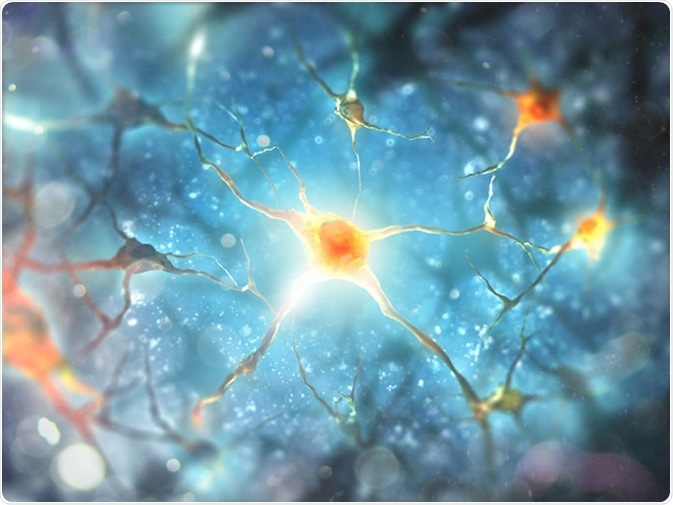Physiotherapy is often used to help recover motor function and movement of joints, muscles and tendons in individuals who are affected by disability, illness or injury. By keeping the muscles active and the joints flexible, it prevents wasting and deterioration of function, as well as promoting rehabilitation.
Neurophysiotherapy is a specialist branch of physiotherapy dedicated to improving the function of patients who have suffered physical impairment caused by neurological conditions.

Neurons and nervous system 3d illustration. Image Credit: Andrii Vodolazhskyi / Shutterstock
In what conditions is neurophysiotherapy used?
Any neurological condition that affects movement and physical ability can be treated using neurophysiotherapy. Some common conditions in which this is useful include:
- Stroke
- Traumatic brain Injury/head Injury
- Spinal cord injury
- Multiple sclerosis (MS)
- Parkinson’s disease
- Bell’s palsy
Depending on the medical condition, the effects may range from motor deficits, paralysis, tremor and spasm to ataxia or lack of sensation. This is because damage to the central nervous system can lead to the breakdown of afferent and efferent pathways carrying nerve signals to and from muscles and organs, causing the symptoms of neurological conditions.
What does neurophysiotherapy consist of?
The aim of neurophysiotherapy is to help rehabilitate physical impairments caused by neurological conditions as already mentioned. It is tailored to the specific needs of each individual with a personalized goal-oriented target. For example, does the patient need big improvements such as learning to walk again, or is it small fine movements that need correction? This will be determined by trained neurological physiotherapists on an initial visit
The brain is able to both lose and form new connections, a phenomenon called neuroplasticity. Neurophysiotherapy is different from traditional physiotherapy in that it takes advantage of this phenomenon, helping the brain to form new synaptic connections. In effect, it rewires the brain to learn or re-learn tasks and abilities.
What is Neurological Physiotherapy?
Neurophysiotherapy can either be conducted on a one-on-one manner, as when the posture is to be improved or a patient needs to re-learn how to walk, stand or sit if the damage is severe. Other tasks such as walking and moderate exercises may also be performed in groups to create a friendlier environment and make rehabilitation more enjoyable.
Neurophysiotherapy does not stop at simple passive exercises or tailored exercises to build strength and coordination. Depending on the extent of motor dysfunction, limb positioning or splints may be prescribed to aid joint recovery. In certain cases, mobility aids may be needed such as a walking frame or specialised wheelchair, including training to use them.
In all cases of neurophysiotherapy, exercises taught by trained neurological physiotherapists are to be repeated both in the clinic and at home on a daily basis to ensure muscle tone and motor function does not deteriorate. These may include simple ‘at-home’ exercises, or frequent visits to the clinic to engage in tailored or group activities.
Rehabilitation will depend on the extent of the brain damage/injury, as well as how early neurophysiotherapy begins. Furthermore, the attitude or willingness of the affected individual is also crucial to success. Caregivers and family members need to be equally engaged in the process, not only to ensure that neurophysiotherapy is being performed both at home as well as in the clinic, but also to improve the patient’s morale and attitude.
Further Reading